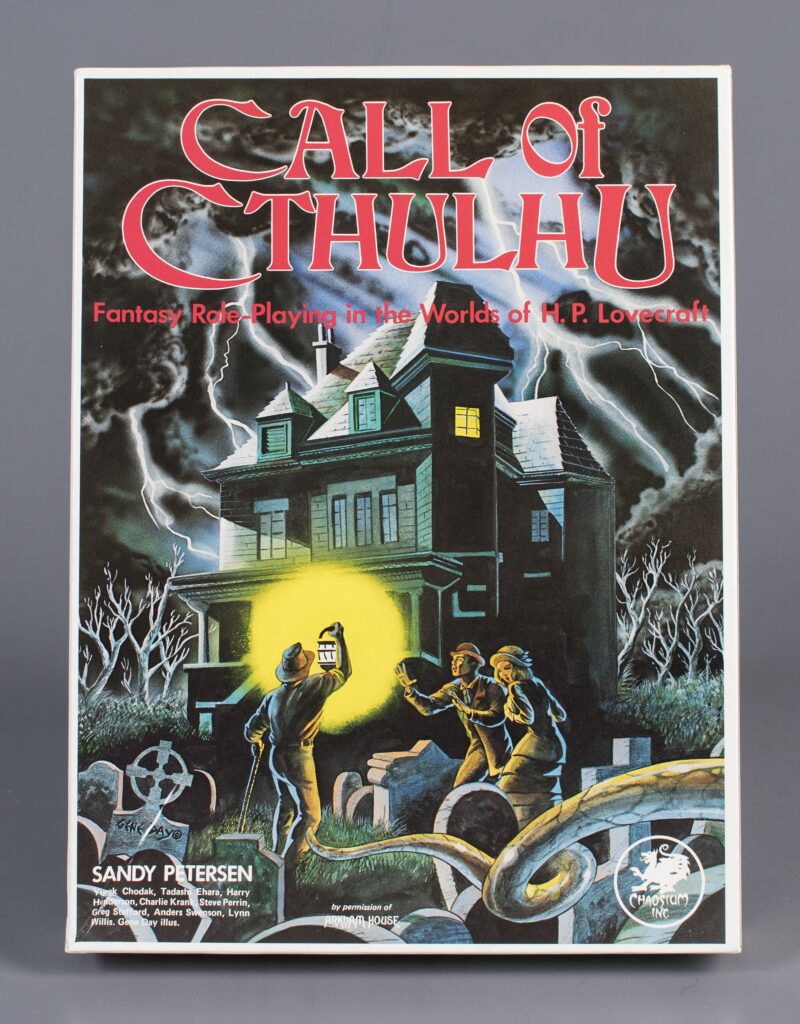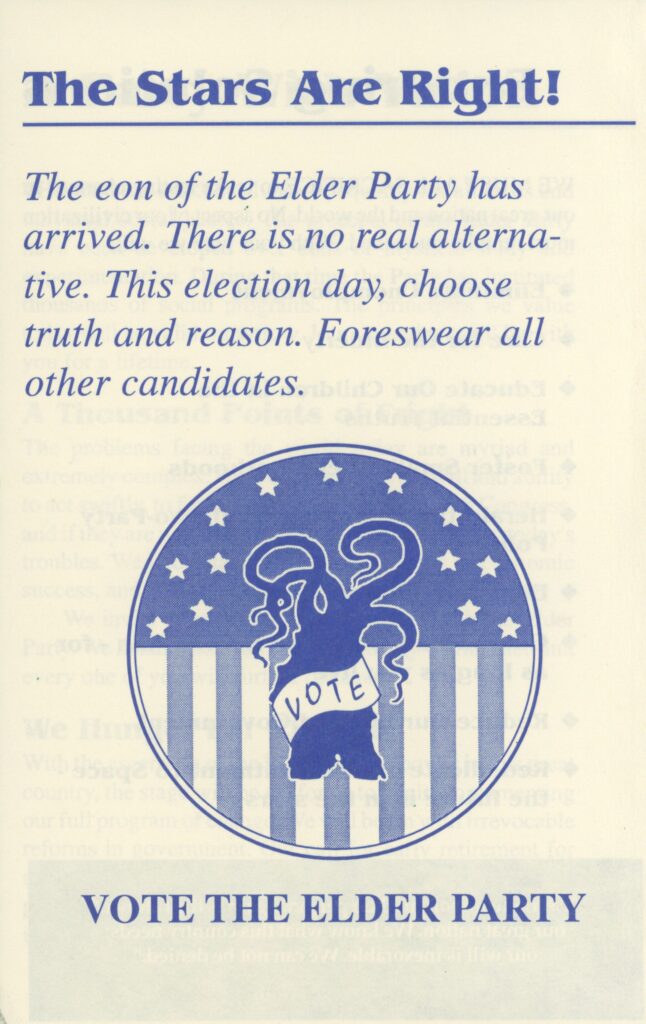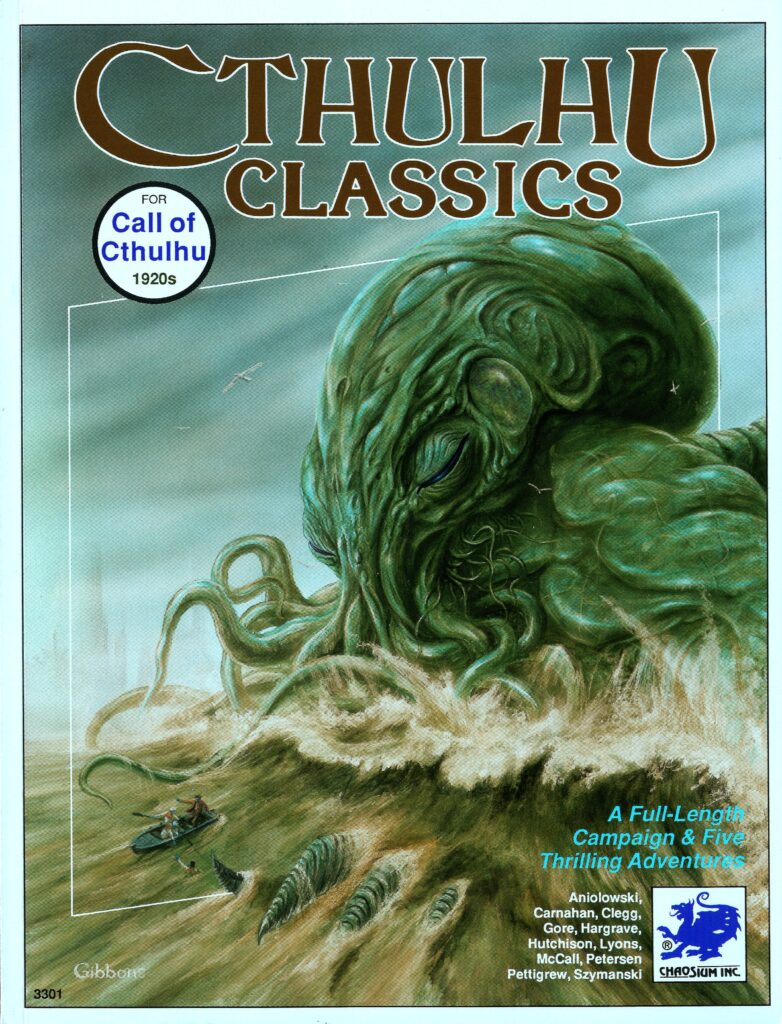Within the last few years, tabletop roleplay games (TTRPGS) have seen a boost in popularity. And while Dungeons & Dragons has become the name synonymous with the game genre in the United States, many other games deserve attention. One game has exerted a great deal of influence over how we play these games today, and has expanded into board games, card games, and video games over the decades. I am talking about Chaosium’s Call of Cthulhu TTRPG. Using the Cthulhu mythos from H.P. Lovecraft’s books, the TTRPG has endured for more than 40 years and, now that it has reached its 7th edition, I thought it was time to take a closer look at this game.

First let us get some big questions out of the way: who is Cthulhu and what is the Cthulhu mythos? Cthulhu is the creation of American author H.P. Lovecraft, who is considered by some to be the father of the cosmic horror genre. Using elements of science-fiction and fantasy, Lovecraft built the mythos of the various types of eldritch beings called the Outer Gods, Elder Gods, and the Great Old Ones. According to Chaosium’s website “Cthulhu is a Great Old One. With the rest of his race, he sleeps in a vast tomb at the bottom of the Pacific Ocean. Cthulhu seems to be the most important Great Old One on Earth.” Featured originally in Lovecraft’s 1928 short story “Call of Cthulhu,” the ancient sleeping being is described as “a monster of vaguely anthropoid outline, but with an octopus-like head whose face was a mass of feelers, a scaly, rubbery looking body, prodigious claws on hind and fore feet, and long, and narrow wings behind.” So Cthulhu ranks as a very scary monster and a thing of nightmares for some. The mythos itself is the various lore, monsters, and the “‘Lovecraftian horror stories” that were created around the sleeping Great Old One.

Jumping ahead to 1975, after receiving a “particularly good tarot card reading,” Greg Stafford decided to take the leap and start a company that would allow him to combine his hobbies in fantasy stories and war games into one. He called it Chaosium. The company is now in its 50th year and has had quite the journey along the way. In the late 1970s, Chaosium acquired the licenses for H.P. Lovecraft’s writings from Arkham House. According to Shannon Appelcline, in November 1981 Sandy Peterson’s Call of Cthulhu TTRPG was released, and gradually it became the company’s top RPG, eventually eclipsing other Chaosium games for most of its history. During times of financial struggles, Chaosium concentrated all its updates and new content on Cthulhu because it was so popular, and eventually it became the company’s signature game. One report recounts that in 1992 when the 5th edition of the game came out, Cthulhu emerged as the core of Chaosium’s image and business, something the company played up with their Cthulhu for President rallies at Gen Con that year.

So what set this game apart from others? While the game’s atmosphere and horror genre certainly contributed, in Appelcline’s writeup on Chaosium’s history in Designers & Dragons states, “Call of Cthulhu changed the way that people thought about roleplaying . . . because it suggested a whole new world of adventure.” This new kind of adventure meant that players were no longer about hacking and slashing their way through combat, but were instead Investigators, average individuals in our world who were encountering the supernatural. It also introduced a “mental landscape” with the sanity system built into the game. This causes the Investigators to experience shocks when they encounter eldritch horrors beyond their comprehension. As these Investigators were just average people, it made the risk of characters succumbing to phobias and other madness a mechanic in the game. This essentially then made a character’s emotional traits part of the character sheet and mechanics, which could help guide a player in how to roleplay their character. Greg Stafford later referred to this kind of roleplaying as story-telling roleplay games. He said these games engaged with the “entirety of the players’ creative capacity, not just his ability to understand the rules. Its emphasis is on the participating in the story, not memorizing the rules.”
It should be noted that while the sanity mechanic was quite influential and significant to the roleplaying scene, it was based on outdated concepts of mental health. The original mechanic depicted the mentally ill as dangerous and out of control. If a player’s character received too much exposure to the supernatural, they would go insane and become unplayable. This is something Stuart Martyn criticizes in his article “Mind Games” in the Horror edition of Wyrd Science zine. Martyn explains how newer editions and offshoots of the game have tried to adjust for more respectful depictions of mental illness, citing Cthulhu Dark by Graham Walmsley as an example in which a character experiences insight into the true nature of reality that others cannot perceive.
This then leads into something interesting about the Call of Cthulhu game: the many licenses that have allowed the TTRPG expand. In fact, Shannon Appelcline says that Chaosium is probably one of the most prolific licensors in the industry and goes on to add, “Most of Chaosium’s licensees were only interested in publishing books for Call of Cthulhu, and Chaosium was happy to oblige.” Some of the TTRPGs it has led to are include the aforementioned Cthulhu Dark, Delta Green and Trials of Cthulhu. In 2001, Wizards of the Coast even came out with d20 Call of Cthulhu, version intended to take the feeling of the original game but with mechanics that would be more familiar to Dungeons & Dragons players. Apart from TTRPGs, Cthulhu has also inspired various card games, board games, and video games. One board game creation based on a Chaosium license was Richard Launius’ 1987 Arkham Horror board game. This game provided roleplay-like elements and stands as perhaps one of the earliest fully cooperative board games, allowing players to work together to defeat a common enemy.

Some of the video games using these licenses were the 1992 and 2024 reimagined Alone in the Dark PC survival horror games, the 2018 Call of Cthulhu by Cyanide, and Call of Cthulhu: Shadow of the Comet from 1993, which used Lovecraft’s stories “The Shadow Over Innsmouth” and “Dunwich Horror” for inspiration. “Dunwich Horror” is included in the current 7th edition of the TTRPG’s Investigator Handbook. The book states that the character Dr. Henry Armitage provides a “prime example of a Call of Cthulhu investigator” in how he uncovers the supernatural and chooses to fight against it instead of running away.
Overall, the influence of Chaosium’s Call of Cthulhu has spanned more than 40 years, creating new ways of portraying characters in TTRPGs by focusing on their mental states and emotions, generating cooperative board games, and inspiring numerous video games that connect back to the TTRPG. So, if you are ever feeling up for something different to play and want to experience some Lovecraftian horror, the options are plentiful whether it be a card game, board game, TTRPG, or video game!


